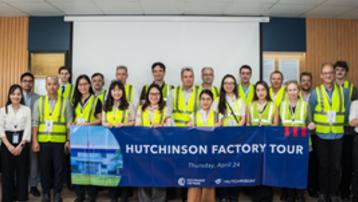How digitalization and new technologies are disrupting the construction sector?

Construction is often considered a traditional occupation. When people think of a building site, manual labour, raw materials, and big mechanical machines are often the first things that spring to mind. However, construction – along with most other sectors – is feeling the impacts of digital transformation.
Innovation in construction

Construction – like most industries – had to adapt during the pandemic. International travel restrictions interrupted the flow of raw materials. Social distancing rules brought building sites to a standstill. And the global economic deep-freeze put investment plans on ice. However, unlike those in the service sector, it is difficult for builders to work at home.
So, construction companies had to innovate. Those who had access to digital or hi-tech solutions like drones or mobile mapping pre-pandemic were at least able to keep remote track of their projects. Like a lot of the digital innovations adopted in haste during the pandemic, these tools and technologies can now help to create a more efficient and effective building sector in the future.
Better aligning with international standards

One of the most common digital tech trends in the construction trade is so-called ‘Building Information Modeling’ (BIM). The idea itself first originated in the 1970s, but started to gain real traction over the last two decades.
In simple terms, buildings used to be designed based on two-dimensional technical drawings like the traditional architect’s blueprint. Now, BIM enables developers to create three-dimensional designs which capture more detailed information about the building – including its construction time, build cost, individual components, and even how sustainable it is – in digital form. This can then be shared among the architects, civil or structural engineers, contractors, and others involved in the construction or maintenance of a project.
The UK developed BIM standards in 2007, and these went on to become the basis of ISO 19650 – the international standard for managing information over the lifetime of a structure built using BIM. Though this hi-tech solution has not achieved widespread adoption in Vietnam, the government hopes to promote it as part of a wider campaign to create a modern, efficient construction sector.
In March 2023, the government published Decision No. 258/QĐ-TTg (Decision 258) on the approval of the roadmap for the application of Building Information Modeling (BIM) in the construction sector. This decision aims to better align Vietnam with global best practice and international building standards.
Following this decision, BIM will be required for so-called ‘Class 1’ or ‘Special Class’ projects, those funded from non-public state investment, and public-private partnership projects. This will then be applied to ‘Class 2’ projects from 2025. These BIM designs will be considered as part of the core building documentation and will form part of construction permit applications, testing, and feasibility reports from 2024 (for Class 1 or Special Class projects) and from 2026 (for Class 2 projects).
Other major organizations are also getting in on the act. For instance, EVN has set up a ‘digital transformation in construction investment’ working group to promote the application of this and other new technologies such as Artificial Intelligence (AI), QR codes, and smart camera monitoring in construction projects.
From blockchain to smart homes
But BIM is just one of the digital solutions in the construction sector. Digitilization is transforming not just the actual construction of buildings, but the administrative processes that underpin it. For instance, digital signatures are becoming more widespread and replacing traditional paper-based procedures such as wet signatures.
Looking further ahead, blockchain-based solutions could also help to streamline, speed up, and make more transparent the administrative procedures in real estate transactions. For example, so-called ‘smart contracts’ – in which legal transactions can be automated and executed as soon as pre-agreed conditions are met – could help to replace traditional escrow agreements requiring independent third parties to manage them.

Meanwhile, tech is not just being used in the construction of buildings. It is also being integrated within the fabric of buildings themselves. Like ‘smart homes’, these so-called ‘smart buildings’ feature seamless interconnected technologies and devices – such as sensors and scanners – to regulate conditions including heating, lighting, and air conditioning. The data from these devices can also be used to optimize the operations of the building to reduce consumption or improve performance.
Opportunities for French companies

Le secteur de la construction au Vietnam est l'un des plus performants de la région Asie-Pacifique, avec des taux de croissance annuels élevés et des investissements étrangers importants. Malgré certains les défis évoqués dans nos différents articles dédiés, le secteur devrait rester un moteur de croissance économique à l'avenir. Toutefois, le secteur de la construction au Vietnam demeure moins développé que dans d'autres pays.
Par conséquent, les entreprises qui optent pour ces solutions et d'autres solutions numériques ont la possibilité de tirer parti de l'avantage du premier arrivé et de s'implanter sur le marché ou d'y prendre une longueur d'avance. Les entreprises françaises innovantes dans les secteurs de la technologie et de la construction ont donc la possibilité de s'implanter et de prospérer au Vietnam, en partageant leurs outils et leurs technologies en partenariat avec des entreprises locales ou en établissant une présence pour elles-mêmes.
This article is part of CCIFV magazine "Connect #11: Building Vietnam's Tomorrow: Challenges and trends in Construction"

Keep up to date with the latest news from the construction sector
Join CCIFV's construction sector committee to exchange ideas with our business community and access the most relevant information.
Learn more
![[Translate to Anglais:] [Translate to Anglais:]](http://aws-a.medias-ccifi.org/fileadmin/_processed_/7/5/csm_gridasia-viglacera-bac-ninh-pers0220231214195526_92c824cbbd.jpg)
